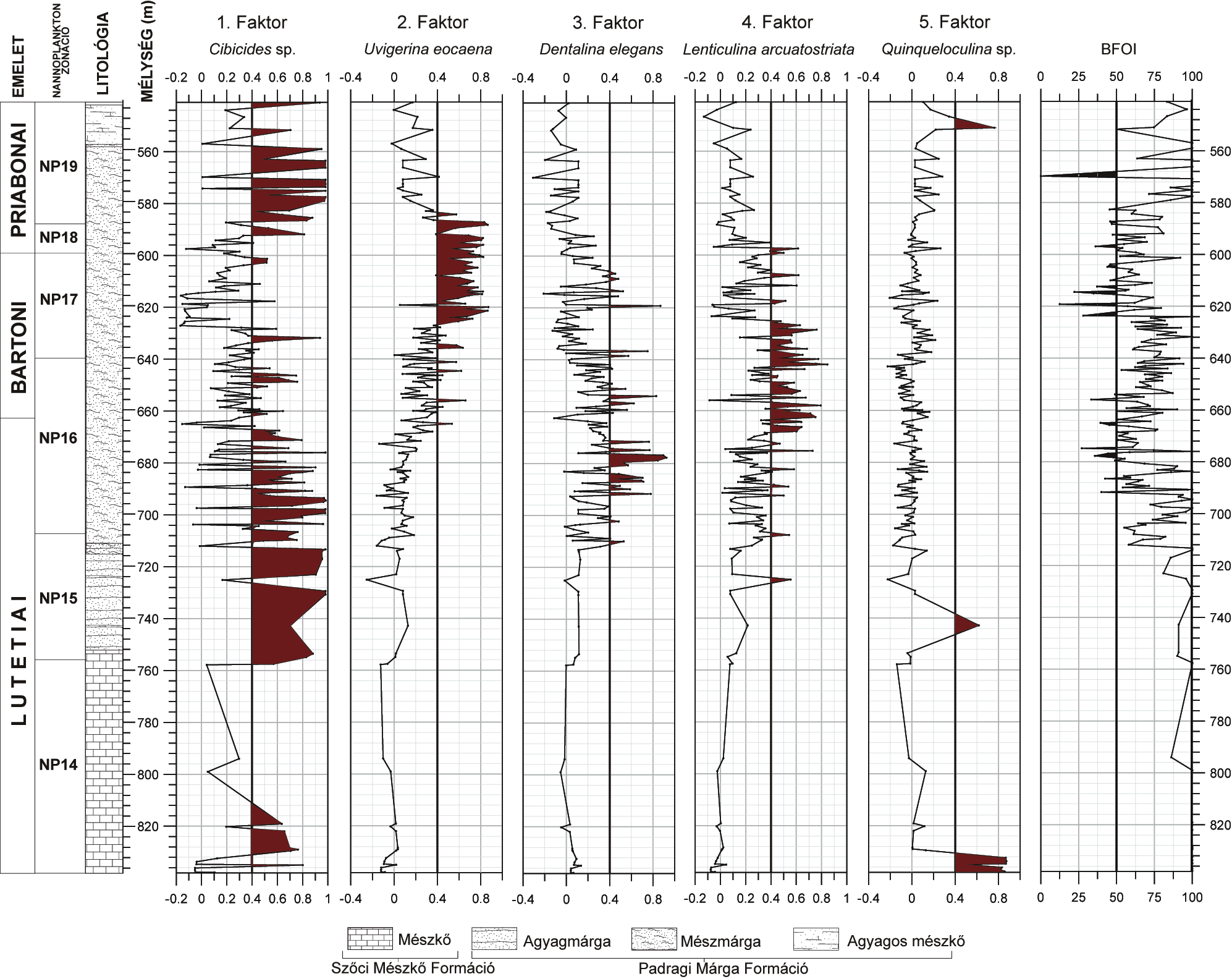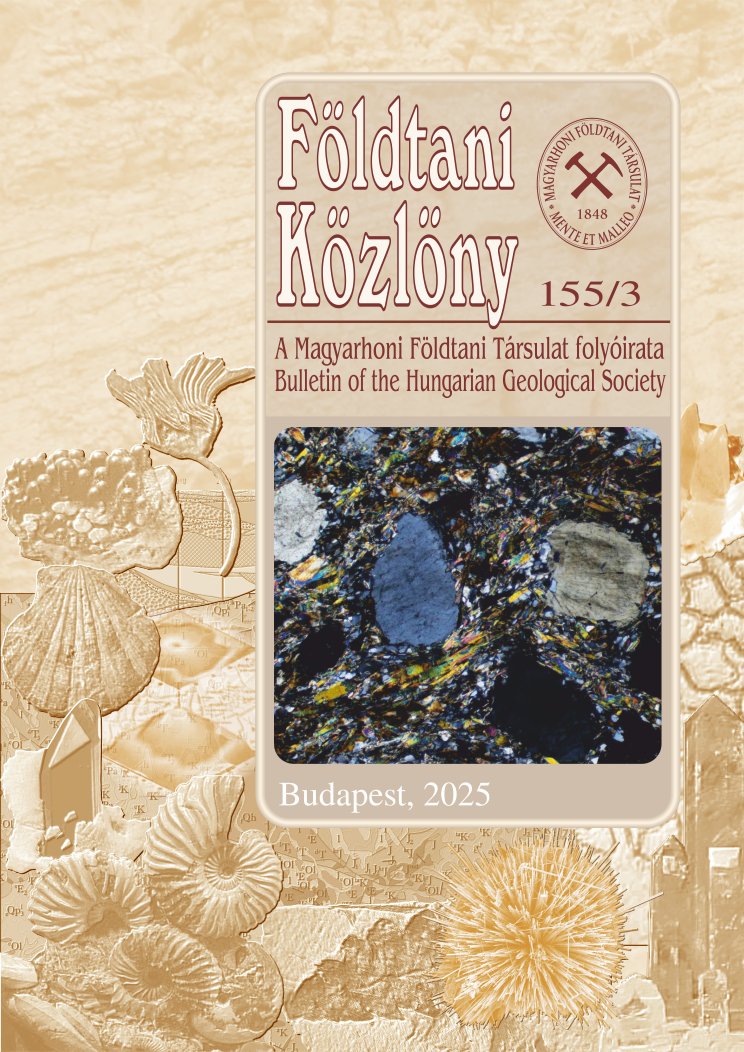A Magyarországi Paleogén Medence paleo-oceanográfiája bentosz foraminiferák paleoökológiai vizsgálata alapján
Absztrakt
A Magyarországi paleogén medence különböző részmedencéiből 14 mélyfúrás és két felszíni szelvény felső-paleo gén rétegsorának bentosz foraminifera faunáját vizsgáltam. A foraminifera közösségek statisztikai elemzéséből rész letes, a paleoökológiai és a paleo-oceanográfiai változásokat jól dokumentáló adatsorokat kaptam. Ezek elemzé séből rekonstruálni tudtam a legfontosabb oceanológiai paramétereket: az egykori sótartalmat, a hőmérsékletet, a vízmélységet, valamint a szervesanyag fluxust. A folyamatos és közel ekvidisztáns mintavételezés alapján a sokváltozós statisztikai módszerek segítségével az említett paraméterek időbeli változását is meghatároztam. Megállapítottam, hogy a középsőés késő-eocén folyamán képződött üledékek a bentosz foraminiferák paleoökológiai elemzése alapján a kontinentális self sekély litorális övétől (5–30 méter), a szublitorális–mélyszublitorális övön keresztül (30–200 méter), a batiális öv felső részéig (200–500 méter) rakódhattak le. A foraminifera közösségek domináns fajai alapján a középső-eocén elejétől a bakonyi területen kialakult medencében fokozatos hőmérséklet-csökkenés feltételezhető. A különböző területeken az időben eltolódó lehűlés a topográfiai különbségeknek köszönhető. A középső- és késő-eocén folyamán az inbentosz és az epibentosz közösségek statisztikai elemzéséből két gyengébb (POMZ1 és POMZ3) és két jelentős (POMZ2 és POMZ4) eutrofizációs folyamat feltételezhető. A paleogén medence korábban feltételezett, helyenként szél ső ségesen gyors ütemű süllyedésének kezdete egybeesik az NP17 zónában kimutatott jelentős eutrofizációs folyamat megindulásával (POMZ2), ami így nem egy döntően tektonikai, hanem egy markáns paleo-oceanográfiai eseménynek is tekinthető.
Hivatkozások
ALTENBACH, A. V. & SARNTHEIN, M. 1989: Productivity record in benthic foraminifera, 255–269. — In: BERGER, W. H., SMETACEK, V. S. & WEFER, G. (Eds.) Productivity of the ocean: Present and past. Life Science Research, New York.
ALVE, E. 1990: Variation in estuarine foraminiferal biofacies with diminishing oxygen condition in Drammensfjord, SE Norway, 661–694. — In: HEMLEBEN, CH., KAMINSKI, M. A., KUHNT, W. & SCOTT, D. B. (Eds.) Paleoecology, biostratigraphy, paleoceanography and taxonomy of agglutinated foraminifera. NATO ASI, series C, 327. https://doi.org/10.1007/978-94-011-3350-0_23
BÁLDI T. 1980: A korai Paratethys története. (The early history of the Paratethys). — Földtani Közlöny 110, 456–472.
BÁLDI T. 1983: Magyarországi oligocén és alsómiocén formációk. (The Oligocene and Lower Miocene formations of Hungary). Akadémiai Kiadó, Budapest, 1–293.
BÁLDI-BEKE, M. & BÁLDI, T. 1991: Paleobathymetry and Paleogeography of the Bakony Eocene Basin in Western Hungary. — Palaeogeography, Palaeoclimatology, Palaeoecology 88, 25–52. https://doi.org/10.1016/0031-0182(91)90013-h
BÁLDI-BEKE M. 1984: A dunántúli képződmények nannoplanktonja. (The nannoplankton of the Transdanubian Paleogene formations). — Geologica Hungarica, series Palaeontologica 43, 1–307.
BERNHARDT B. 1984: A dunántúli-középhegységi eocén szénképződés fejlődéstörténeti körvonalairól. (Evolution of coal-bearing formations of the Transdanubian Central Range). — Kézirat, Országos Földtani és Geofizikai Adattár, 1–29.
BERNHARDT B., BÁLDI-BEKE M., LANTOS M., HORVÁTH-KOLLÁNYI K. & MÁRTON P. 1988: Eocene magneto- and biostratigraphy at Somlóvásárhely, Hungary. — Acta Geologica Hungarica 31, 33–52.
BETZLER, C., BRACHERT, T. C. & NEBELSICK, J. 1997: The warm temperate carbonate province. A review of the facies, zonations and deliminations. — Senckenberg 201, 83–99.
BODA, J. & MONOSTORI, M. 1972: Adatok a budai márga képződési körülményeihez. (Contributions to the Formation of the ”Buda Marls” (Paleogene)). — Őslénytani Viták 20, 63–70.
BODA, J. & MONOSTORI, M. 1973: Üledékmozgási jelenség a budai márgában. (Turbiditic events in the Buda Marl Formation). — Földtani Közlöny 103, 109–201.
BOERSMA, A., PREMOLIISILVA, I. & SHACKLETON, N. J. 1987: Atlantic Eocene planktonic foraminiferal paleohydrographic indicators and stable isotope paleoceanography. — Paleoceanography 2/3, 287–331. https://doi.org/10.1029/pa002i003p00287
CORLISS, B. H. & EMERSON, S. 1990: Distribution of Rose Bengal stained deep-sea benthic foraminifera from the Nova Scotian continental margin and Gulf of Maine. — Deep-Sea Research 37, 381–400. https://doi.org/10.1016/0198-0149(90)90015-n
DE RIJK, S., TROELSTRA, S. R., & ROHLING, E. J. 1999: Benthic foraminiferal distribution in the Mediterranean Sea. — Journal of Foraminiferal Research 29, 93–103. https://doi.org/10.2113/gsjfr.29.2.93
FODOR L., MAGYARI Á., FOGARASI A., & PALOTÁS K. 1994: Tercier szerkezetfejlődés és késő paleogén üledékképződés a Budai-hegységben. A Budai vonal új értelmezése. (Tertiary tectonics and Late Paleogene sedimentation in the Buda Hills, Hungary. A new interpretation of the Buda Line). — Földtani Közlöny 124, 129–305.
HANTKEN, M. 1871: Az esztergomi barnaszénterület földtani viszonyai. (Geology of the brown coal field of Esztergom, Hungary) — Magyar Királyi Földtani Intézet Évkönyve 1871, 3–140.
HARDENBOL, J., THIERRY, J., FARLEY, M.B., JACQUIN, TH., DE GRACIANSKY, P.C. & VAIL, P.R. 1998: Mesozoic and Cenozoic Sequence Chronostratigraphic Framework of European basins. — SEPM Special Publication 60, 1–364. https://doi.org/10.2110/pec.98.02.0003
HORVÁTH-KOLLÁNYI K. 1983: Az ÉK dunántúli terület eocén plankton Foraminifera zónái. (Paleogene plankton foraminifera zonation of NE part of the Transdanubian Central Range). — Földtani Közlöny 113, 225–236.
HORVÁTH-KOLLÁNYI K. & NAGY-GELLAI, Á. 1989: Palaeobathymetric study of Paleogene profiles upon Foraminifera. — Magyar Állami Földtani Intézet Évi Jelentése 1989/2, 115–131.
JORISSEN, F.J. 1987: The Distribution of Benthic Foraminifera in the Adriatic Sea. — Marine Micropaleontology 12, 21–48. https://doi.org/10.1016/0377-8398(87)90012-0
KAIHO, K. 1991: Global changes of Paleogene aerobic/anaerobic benthic foraminifera and deep-sea circulation. — Palaeogeography, Palaeoclimatology, Palaeoecology 83, 65–85. https://doi.org/10.1016/0031-0182(91)90076-4
KAIHO, K. 1994: Benthic foraminiferal dissolved oxygen index and dissolved oxygen levels in the modern ocean. — Geology 22, 719–722. https://doi.org/10.1130/0091-7613(1994)022<0719:bfdoia>2.3.co;2
KAIHO, K. 1999: Effect of organic carbon flux and dissolved oxygen on the benthic foraminiferal oxygen index (BFOI). — Marine Micropaleontology 37, 67–76. https://doi.org/10.1016/s0377-8398(99)00008-0
KERCSMÁR ZS., FODOR L., PÁLFALVI S. 2006: Tectonic control and basin evolution of the Northern Transdanubian Eocene Basins (Vértes Hills, Central Hungary). — Geolines 20, 64-66.
KERCSMÁR ZS. (SZERK.), BUDAI T., CSILLAG G., SELMECZI I., SZTANÓ O. 2015: Magyarország felszíni képződményeinek földtana. Magyarázó Magyarország földtani térképéhez (1:500 000). (Surface geology of Hungary. Explanatory notes to the Geological map of Hungary (1: 500 000). — Magyar Földtani és Geofizikai Intézet, 1–62.
KOLLÁNYI K., VETŐ I., & HERTELENDI, E. 1997: Változások a bakonyi eocén tengerben foraminiferák izotóp összetétele tükrében. (Environmental changes in the Eocene sea of the Bakony Mts., Hungary as reflected by isotopic ratios of benthic and planktonic Foraminifera). — Földtani Közlöny 127, 111–126.
KOLLÁNYI K, BERNHARDT B., BÁLDI-BEKE M. & LANTOS M. 2003: Dunántúli eocén fúrások integrált sztratigráfiai vizsgálata. (Integrated stratigraphic examination of the Eocene boreholes in Transdanubia). — Földtani Közlöny 133, 69-90.
LESS GY. 1987: Palaeontology and Stratigraphy of the European Orthophragminae. — Geologica Hungarica, series Palaeontologica 51, 1–373.
LUTZE, G. F. 1980: Depth distribution of benthic foraminifera from the continental margin of NW Africa. — Meteor Forschungsarbeit 32, 31–80.
MALMGREN, A. & HAQ, B. U. 1982: Assessment of quantitative techniques in Paleobiogeography. — Marine Micropaleontology 31/3, 221–448. https://doi.org/10.1016/0377-8398(82)90003-2
MURRAY, J. W. 1991: Ecology and palaeoecology of benthic foraminifera. — Longman, London, 397 p.
MURRAY, J. W. 2006: Ecology and Applications of Benthic Foraminifera. — Cambridge University Press, 423 p. https://doi.org/10.1017/CBO9780511535529
NAGYMAROSY A. 1990a: From Tethys to Paratethys, a way of survival. — Acta geodaetica, geophysica et montanistica Hungarica 25, 373–385.
NAGYMAROSY A. 1990b: Palegeographical and paletectonical outlines of some Intra-Carpathian Paleogene basins. — Geologica Carpathica 41, 259–274.
NAGYMAROSY A. & BÁLDI-BEKE M. 1988: The position of the Paleogene formations of Hungary in the Standard Nannoplankton Zonation. — Annales Universitatis Scientiarum Budapestinensis de Rolando Eötvös nominatae, sectio Geologica 28, 3–25.
OBERHÄNSLI, H., MÜLLER-MERZ, E. & OBERHÄNSLI, R. 1991: Eocene paleoceanographic evolution at 20–30 °S in the Atlantic Ocean. — Palaeogeography, Palaeoclimatology, Palaeoecology 83, 173–215. https://doi.org/10.1016/0031-0182(91)90079-7
OZSVÁRT P. 1999: Middle Eocene foraminifer, mollusc and ostracod fauna from the Csordakút Basin (Gerecse Mountains, Hungary): palaeoenviroments recorded in a transgressive sequence. — Annales Universitatis Scientiarum Budapestinensis, sectio Geologica 32, 73–135.
OZSVÁRT P. 2003: A magyarországi paleogén medence paleo-oceanográfiája bentosz foraminiferák ökológiai vizsgálata alapján. (Paleoceanographic history of the Hungarian Paleogene Basin by paleoecological analysis of benthic foraminifera). — PhD értekezés, ELTE Őslénytani Tanszék, (PhD thesis, ELTE, Department of Palaeontology), Budapest, 182 p.
OZSVÁRT P. 2007: Middle and Late Eocene Benthic foraminiferal fauna of the Hungarian Paleogene Basin: systematics and paleoecology. — Geologica Pannonica, Special Publication 2, 1–127.
OZSVÁRT, P., KOCSIS, L., NYERGES, A., GYŐRI, O. & PÁLFY, J. 2016: The Eocene-Oligocene climate transition in the Central Paratethys. — Palaeogeography, Palaeoclimatology, Palaeoecology 459, 471-487. https://doi.org/10.1016/j.palaeo.2016.07.034
PODANI J. 1997: Bevezetés a sokváltozós biológiai adatfeltárás rejtelmeibe. (Introduction to the analysis of multivariate biological data). — Scientia, Budapest, 412 p.
ROYDEN, L. & HORVÁTH F. (Eds.) 1998: The Pannonian Basin – a Study in Basin Evolution. — AAPG Memoire 45, 394 p. https://doi.org/10.1306/0c9b249d-1710-11d7-8645000102c1865d
SCHERBACHER, M., SCHMIEDL, G., & HEMLEBEN, CH. 2001: Early Oligocene benthic Foraminifera from the Lower Inn Valley area: implications for the paleoenvironmental evolution of the Inneralpine Molasse, 611–640. — In: PILLER, E. & RASSER, M., W. (ed.), Paleogene of the Eastern Alps. Österr. Akad. Wiss., Schriftenr. Erdwiss. Komm, Wien.
SCHMIEDL, G., SCHERBACHER, M., BRUCH, A. A., JELEN, B., NEBELSICK, J. HEMLEBEN, CH., MOSBRUGGER, V. & RIFEL, H: 2002: Paleoenvironmental evolution of the Paratethys in the Slovenian Basin during the Late Paleogene. — International Journal of Earth Sciences 91, 123–132. https://doi.org/10.1007/s005310000118
SEN GUPTA, B. K. & MACHIAN-CASTILLO, M. L. 1993: Benthic foraminifera in oxygen poor habitats. — Marine Micropaleontology 20, 183–201. https://doi.org/10.1016/0377-8398(93)90032-s
SGARRELLA, F. & MONTCHARMONT ZEI, M. 1993: Benthic foraminifera of the Gulf of Naples (Italy): Systematic and autecology. — Bolletino Soc. Paleontologia Italiana 32, 145–246.
SZTANÓ O. & FODOR L. 1997: Lejtőüledékek a paleogén medence peremén: A felső-eocén Piszkei Márga (Nyergesújfalu, Sánc-hegy) ülepedési és szerkezeti viszonyai. (Bathyal slope deposits in the Paleogene Basin: A case study of the Upper Eocene Piszke Marl (Nyergesújfalu, Sánc Hill, Hungary). — Földtani Közlöny 127, 267–290.
TARI G. 1994: Alpine tectonics of the Pannonian Basin. — PhD értekezés, Rice University, Houston, 501 p.
TELEGDI–ROTH K. 1927: Infraoligocén denudáció nyomai a Dunántúli-Középhegység északnyugati peremén. (Tracing of infraoligocene denudation in NW part of Transdanubian Central Range). — Földtani Közlöny 57, 117–128.
VARGA P. 1985: Mészturbidites betelepülesek a Budai Márgában és a Tardi Agyagban. (Turbiditic limestone intercalations of the Buda Marl and Tard Clay). — Őslenytani Vitak 31, 93–99.
VETŐ, I., OZSVÁRT, P., FUTÓ, I. & HETÉNYI, M., 2007: Extension of carbon flux estimation to oxic sediments based on sulphur geochemistry and analysis of benthic foraminiferal assemblages: a case history from the Eocene of Hungary. — Palaeogeography, Palaeoclimatology, Palaeoecology 248, 119–144. https://doi.org/10.1016/j.palaeo.2006.12.001
VOGL, M. 1910: A piszkei bryozoás márga faunája. (Fossils of Bryozoan Marl from Piszke). — Földtani Intézet Évkönyve 18, 175–204.
VÖRÖS A. 1989: Middle Eocene transgression and basin evolution in the Transdanubian Central Range, Hungary: sedimentological contributions. — Fragmenta Mineralogica et Paleontologica 14, 63–72.
WADE, B. S. & KROON, D: 2002: Middle Eocene regional climate instability: Evidence from the western North Atlantic. — Geology 30, 1011–1014. https://doi.org/10.1130/0091-7613(2002)030<1011:mercie>2.0.co;2


















